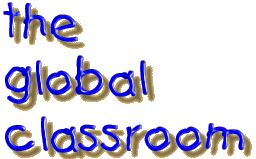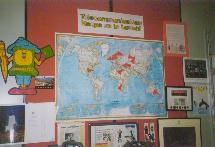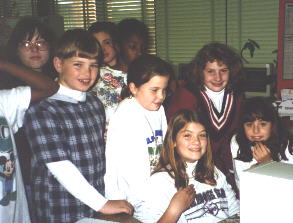

In 1991 I walked into a session on telecommunications at a state computer conference and not only had no idea what telecommunication was ... I had no idea how that session would change my life and my classroom. I saw a presenter 'chat' on the screen with his students miles away who were quite unhappy with their substitute while he presented at the conference. This was the 'hook' that lured me into the online world. I was determined to discover this world for myself.
At first my students and I joined our state education network which was not connected to the Internet. I met many instate teachers who had that same excitement that I felt for this new technology. My network legs were wobbly at first but, as always, help was never far away. After a year and many inquiries I got my first 'ticket' on the Internet - an Internet address to write to! This address eventually led me and my students to KIDLINK.
 Suddenly there were maps all
over the walls of my computer labs in each of my two schools.
Flags pinpointing states and countries where our new friends
live are still popping up all over. Now, filling the spaces
between a world map and a map of the USA, are gorgeous photo
posters of our keypal friends. We have smiling faces of
teachers and students in Finland, Iceland, Russia, Tasmania,
Peru, the United Kingdom, Japan, Brazil, Arizona, Washington,
South Carolina and Maryland.
Suddenly there were maps all
over the walls of my computer labs in each of my two schools.
Flags pinpointing states and countries where our new friends
live are still popping up all over. Now, filling the spaces
between a world map and a map of the USA, are gorgeous photo
posters of our keypal friends. We have smiling faces of
teachers and students in Finland, Iceland, Russia, Tasmania,
Peru, the United Kingdom, Japan, Brazil, Arizona, Washington,
South Carolina and Maryland.
 Along with photos we have videos of our friends in Finland,
Japan, the United Kingdom and Peru. We have .gif files from
the Netherlands, the United Kingdom, Denmark, Japan, Russia,
Turkey, Egypt, Australia, Israel, Finland and the USA. Many parcels
loaded with books, trinkets and goodies have arrived via snail mail.
Along with photos we have videos of our friends in Finland,
Japan, the United Kingdom and Peru. We have .gif files from
the Netherlands, the United Kingdom, Denmark, Japan, Russia,
Turkey, Egypt, Australia, Israel, Finland and the USA. Many parcels
loaded with books, trinkets and goodies have arrived via snail mail.
We have received a Russian tune in a sound file and now even send the voices of children as e-mail. Our vision impaired 6th grade student talked into a microphone connected to the computer and made a message by voice to send to our friends in Japan.
Are we linked to a larger teaching and learning community? You bet we are! Our class size isn't limited by legislation to 30 students. The world is our classroom! All are welcomed in... Our schedule isn't regulated by a clock but by the desire to meet new people and learn things we never knew before. Our subjects aren't divided into neat pockets of math, science, social studies and language arts. In the global classroom the curriculum is a 'living' curriculum with real people - not textbooks - feeding our desire to learn and explore.
Students in a remote village of Alaska have told my students that they must travel in and out of their village by airplane. A student in Peru who actually came to visit us here in Maryland shared his unfortunate experience with street kids. His father stunned the class with his explanation of the terrorist group in Peru called the 'Sendero Luminoso.'
My curriculum has never been so alive, so up to date, so exciting for me. My planning time starts early. My day begins online at 5:30 AM and ends around 11:00 PM. Long hours? Absolutely. Why do I do it? Once you are part of the global community you can't settle for less. It's that simple. The world is at your fingertips. Friends who are 10 time zones away are only minutes away on the screen.
The children catch the excitement too, for you see... my telecom class is voluntary. I'm not their teacher... we meet at recess and after school. ...and I always have to turn some away... because there aren't enough seats and computers in my tiny lab.
Patricia Weeg
pweeg@shore.intercom.net